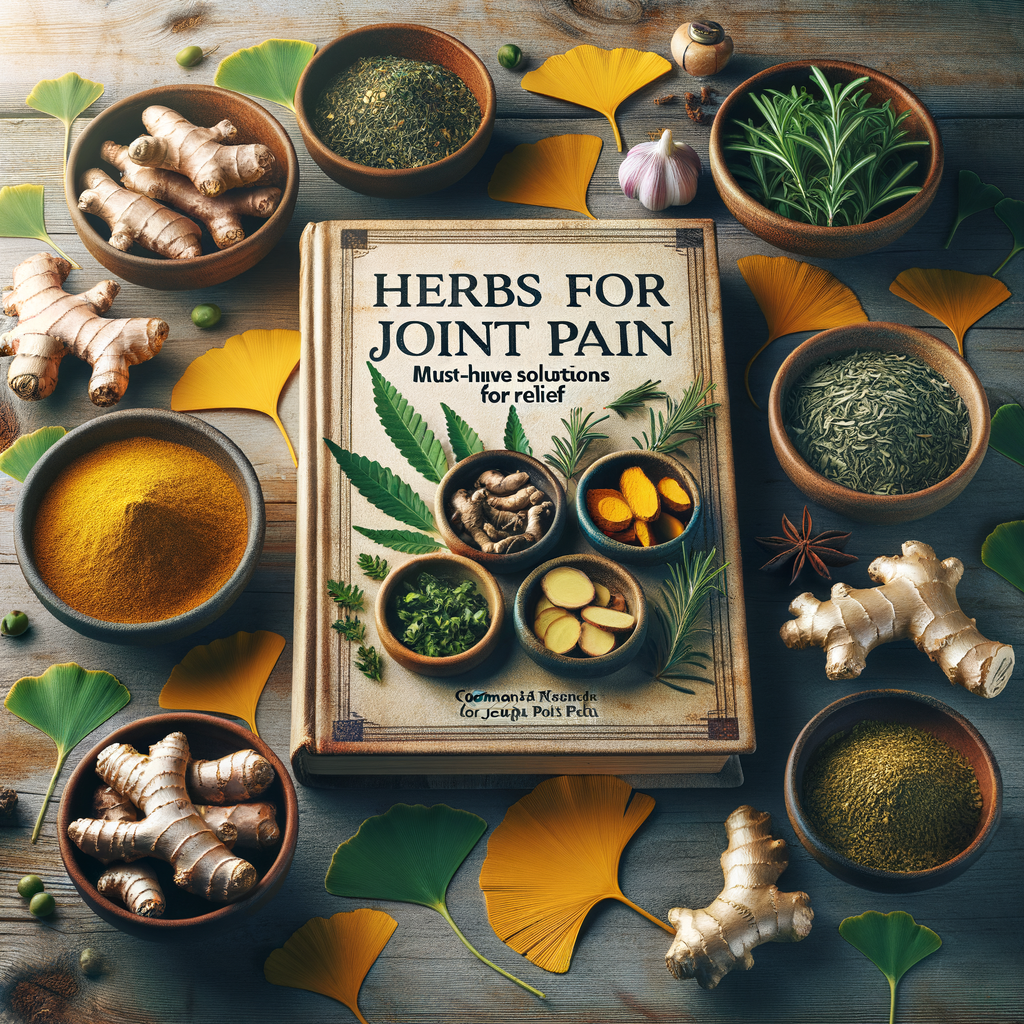
- Herbs for Joint Pain: Understanding Natural Relief
- The Science Behind Herbs for Joint Pain
- Top Herbs for Joint Pain Relief
- 1. Turmeric
- 2. Ginger
- 3. Boswellia
- 4. Devil’s Claw
- 5. Willow Bark
- Additional Herbal Remedies for Joint Pain
- How to Incorporate Herbs into Your Routine
- Cooking
- Teas and Infusions
- Supplements
- Lifestyle Changes to Complement Herbal Remedies
- Maintain a Healthy Diet
- Stay Active
- Manage Stress
- Consult with Healthcare Providers
- Frequently Asked Questions
- 1. Can I use these herbs alongside prescription medications?
- 2. How quickly will I feel the effects of these herbs?
- 3. Are there any side effects to using these herbs?
- 4. How should I store herbal supplements?
- 5. Can I use these herbs for other ailments?
- 6. What is the best way to prepare ginger for consumption?
- 7. How long should I take herbs for joint pain?
- 8. Are there specific diets that enhance the effects of these herbs?
- 9. Is there a specific time of day to take these herbs?
- 10. Can I grow herbs for joint pain in my garden?
- Conclusion
- References
Herbs for Joint Pain: Understanding Natural Relief
Herbs for joint pain offer promising solutions for those seeking relief. Millions struggle with joint discomfort, seeking alternatives to conventional medications. Natural remedies, especially herbs, have gained popularity not only for their effectiveness but also for their minimal side effects. This article will provide you with a detailed look at various herbs known for their potential in alleviating joint pain.
The Science Behind Herbs for Joint Pain
Herbs have been a part of traditional medicine for centuries. Their benefits often stem from active compounds that can reduce inflammation and improve circulation. These properties make several herbs effective in managing joint pain.
Many studies support the effectiveness of herbs in relieving symptoms associated with arthritis and other joint issues. For instance, turmeric contains curcumin, a compound known for its powerful anti-inflammatory effects. Similarly, ginger contains gingerol, which has been shown to reduce pain and swelling. Understanding the science helps reinforce the value of incorporating these herbs into your wellness routine.
Top Herbs for Joint Pain Relief
Several herbs stand out when it comes to providing relief from joint pain. Here’s a look at some of the most effective options.
1. Turmeric
Turmeric is a golden spice known for its anti-inflammatory properties. The key ingredient, curcumin, blocks inflammatory pathways in the body. This action helps lessen pain and improve mobility for those suffering from arthritis.
How to Use: You can add turmeric to your cooking, drink turmeric tea, or take it as a supplement.
2. Ginger
Ginger is not only a flavorful spice but also a remarkable herb for joint pain. Research has shown that ginger may help reduce pain and swelling in osteoarthritis and rheumatoid arthritis.
How to Use: Grate fresh ginger into tea or add it to soups and stir-fries. Ginger supplements are also widely available.
3. Boswellia
Boswellia, also known as frankincense, comes from the resin of the Boswellia tree. It has potent anti-inflammatory effects. Many studies suggest that it can improve pain and function in those with osteoarthritis.
How to Use: Look for Boswellia extract in capsule form or as a powder that can be added to smoothies.
4. Devil’s Claw
Devil’s Claw is an herb native to southern Africa and has shown promising results in reducing pain. It may help alleviate symptoms of osteoarthritis and lower back pain.
How to Use: You can find it in capsule or tincture form. Always consult with a healthcare provider before beginning any new regimen.
5. Willow Bark
Willow bark has been used for centuries as a natural pain reliever. It contains salicin, which the body converts into salicylic acid. This compound has similar effects to aspirin, helping reduce inflammation and pain.
How to Use: It is available in tea, powder, or capsule forms.
Additional Herbal Remedies for Joint Pain
In addition to the herbs listed above, several others can also help. Let’s take a look.
| Herb | Key Benefits |
|———————|—————————————-|
| Cat’s Claw | May reduce inflammation and improve mobility. |
| Rosemary | Contains antioxidants and may ease joint stiffness. |
| Cayenne | Capsaicin may help numb joint pain when applied topically. |
How to Incorporate Herbs into Your Routine
Adding herbs to your daily life can be rewarding and easy. Here are some practical tips for incorporation:
Cooking
Use these herbs in your cooking for added flavor and benefits. For example, sprinkle turmeric on roasted vegetables or add ginger to your stir-fries.
Teas and Infusions
Herbal teas are a great way to enjoy the benefits of these herbs. For instance, mix turmeric and ginger for a soothing drink. This method not only tastes good but also provides health benefits.
Supplements
Consider herbal supplements if you’re looking for more concentrated doses. Be sure to choose high-quality brands and consult with a healthcare professional for guidance.
Lifestyle Changes to Complement Herbal Remedies
While herbs can provide significant relief, integrating lifestyle changes can enhance their effectiveness. Here are some simple adjustments you can make:
Maintain a Healthy Diet
Eating a balanced diet rich in omega-3 fatty acids, antioxidants, and fiber can support joint health. Foods like fatty fish, nuts, and leafy greens can be beneficial.
Stay Active
Gentle, low-impact exercises can help maintain joint mobility. Activities like swimming, walking, and yoga are excellent choices.
Manage Stress
Chronic stress can exacerbate pain. Implementing stress-reducing techniques, such as meditation or deep breathing exercises, can improve your overall well-being.
Consult with Healthcare Providers
It’s crucial to consult with a healthcare provider before starting any herbal remedies. They can provide valuable insights into the right herbs, dosages, and interactions with any medications you may be taking. This step can ensure your safety and maximize the benefits of your herbal regimen.
Frequently Asked Questions
1. Can I use these herbs alongside prescription medications?
Always consult your healthcare provider before combining herbal supplements with prescription drugs.
2. How quickly will I feel the effects of these herbs?
Effects can vary greatly. Some users report immediate relief, while others may take weeks to notice changes.
3. Are there any side effects to using these herbs?
Some people may experience side effects, such as upset stomach or allergic reactions. It’s crucial to monitor your body’s responses.
4. How should I store herbal supplements?
Keep them in a cool, dry place, away from direct sunlight. Ensure they are tightly sealed to maintain their potency.
5. Can I use these herbs for other ailments?
Many herbs have multiple uses. For instance, turmeric and ginger also support digestive health.
6. What is the best way to prepare ginger for consumption?
Fresh ginger can be grated and added to meals, brewed in tea, or blended into smoothies.
7. How long should I take herbs for joint pain?
Consult your healthcare provider for personalized guidance on duration and dosage.
8. Are there specific diets that enhance the effects of these herbs?
A diet rich in anti-inflammatory foods, such as fruits, vegetables, and whole grains, can complement the effects of these herbs.
9. Is there a specific time of day to take these herbs?
You can take most herbs at any time. However, following the specific guidelines on the packaging is best.
10. Can I grow herbs for joint pain in my garden?
Absolutely! Many herbs, like ginger and rosemary, can be grown at home. They are both easy to cultivate and provide fresh ingredients for your kitchen.
Conclusion
Herbs for joint pain can provide significant relief for those seeking natural solutions. Incorporating these herbs into your daily routine can enhance your overall well-being and improve your quality of life. Always consult with a healthcare provider to ensure you are making the best choices for your health. By combining herbs with a healthy lifestyle, you can take important steps toward managing and alleviating joint pain effectively.
References
1. National Center for Complementary and Integrative Health. (n.d.). Turmeric. NCCIH
2. Arthritis Foundation. (n.d.). Ginger for Osteoarthritis. Arthritis Foundation
3. WebMD. (2022). Devil’s Claw. WebMD
4. Healthline. (2021). Herbs for Arthritis. Healthline
5. Mayo Clinic. (2020). Supplements for Joint Pain Relief. Mayo Clinic



